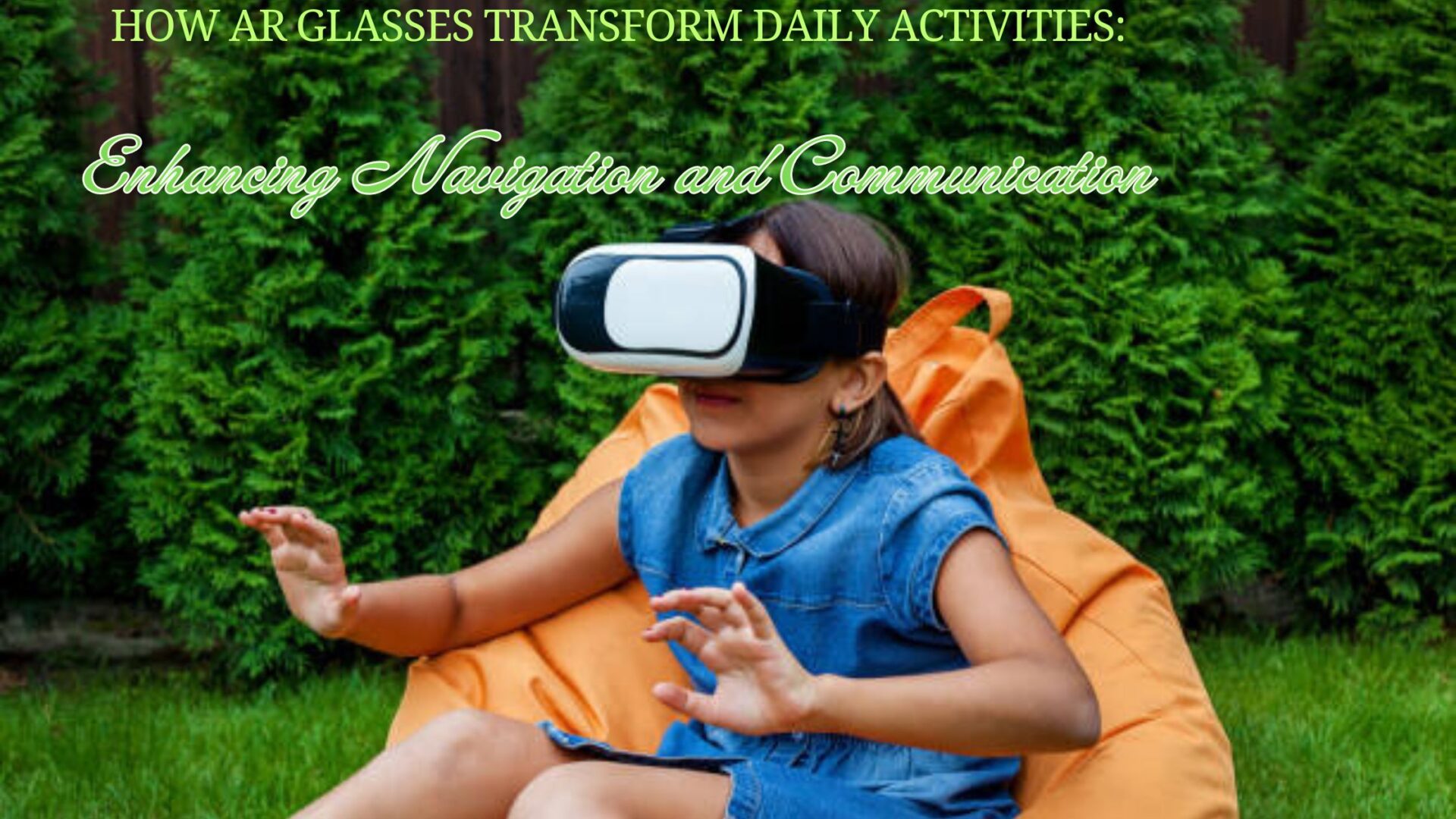Introduction:-
How AR Glasses Transform Daily Activities: Enhancing Navigation and Communication

In the realm of technology, Augmented Reality (AR) glasses have emerged as a transformative force, reshaping how we perceive and interact with our surroundings. This innovative technology seamlessly overlays digital information onto our physical world, creating a captivating blend of the virtual and tangible. In this article, we delve into the transformative potential of AR glasses, focusing on their impact on navigation and communication.
How AR Glasses Transform Daily Activities:
- Real-Time Directions:
- AR glasses can overlay navigation instructions directly onto the user’s field of view, providing turn-by-turn directions without the need to look at a phone or GPS device.
- Landmark Identification:
- They can identify and highlight landmarks, buildings, or points of interest, making it easier for users to orient themselves in unfamiliar environments.
- Public Transit Information:
- AR glasses can display real-time information about public transportation schedules, routes, and delays, helping users plan their journeys more efficiently.
- Indoor Navigation:
- In large indoor spaces like malls, airports, or museums, AR glasses can provide detailed indoor maps and directions, guiding users to their destinations without confusion.
Communication
- Hands-Free Calling:
- Users can make and receive phone calls hands-free, with the caller’s information displayed on the glasses, allowing for safer and more convenient communication while on the go.
- Real-Time Translation:
- AR glasses can provide real-time translation of spoken and written language, displaying translated text directly in the user’s field of view, which is especially useful for travelers in foreign countries.
- Notifications and Messages:
- Notifications for emails, messages, and social media can be displayed discreetly on the glasses, allowing users to stay connected without constantly checking their phones.
- Video Conferencing:
- With built-in cameras and microphones, AR glasses can facilitate video calls, enabling face-to-face communication and collaboration in a more immersive way.
Other Enhancements
- Information Overlay:
- AR glasses can provide contextual information about objects, products, or people in the user’s environment. For instance, looking at a product in a store might bring up reviews and price comparisons.
- Productivity Tools:
- They can assist with productivity by displaying to-do lists, calendar events, and reminders directly in the user’s field of view, helping with time management and organization.
- Entertainment:
- AR glasses can enhance entertainment experiences by overlaying digital content onto the real world, such as interactive games, virtual tours, or immersive educational content.
- Health and Fitness:
- For fitness enthusiasts, AR glasses can provide real-time data on workouts, display health metrics like heart rate, and even offer guided exercises and routines.
In summary, AR glasses integrate seamlessly into various aspects of daily life, making tasks more intuitive, efficient, and enjoyable through the power of augmented reality.
What are the differences between AR glasses offered by Apple and Google?
Apple and Google, two tech giants, have both ventured into the augmented reality (AR) glasses market, offering unique features and experiences. While Apple’s AR glasses are still highly anticipated and not officially released as of now, Google has had its Google Glass and other AR projects. Here’s a comparison based on available information and market expectations:

Design and Hardware
Apple AR Glasses
- Design:
- Expected to have a sleek, lightweight, and fashionable design, similar to regular eyeglasses.
- May include interchangeable lenses to cater to both prescription and non-prescription users.
- Display:
- Anticipated to feature high-resolution, holographic waveguide displays for a crisp and immersive AR experience.
- Sensors and Cameras:
- Likely to be equipped with advanced sensors for spatial awareness and hand gesture recognition.
- Potential for multiple cameras for 3D mapping and real-time environmental interaction.
- Integration:
- Deep integration with Apple’s ecosystem (iPhone, Apple Watch, and other devices) for seamless user experience.
Google Glass
- Design:
- Original Google Glass had a more industrial and functional design, less focused on fashion.
- Google Glass Enterprise Edition is designed for business and industrial applications with a durable frame.
- Display:
- Utilizes a small prism display in the corner of the user’s field of view, providing a heads-up display (HUD) experience.
- Sensors and Cameras:
- Features basic sensors for head tracking and a single front-facing camera for taking photos and videos.
- Limited hand gesture recognition capabilities compared to expectations for Apple’s offering.
- Integration:
- Works with Android devices and some limited integration with other Google services and ecosystems.
Software and Functionality
Apple AR Glasses
- Operating System:
- Expected to run on a version of iOS, possibly named rOS (reality Operating System).
- Applications:
- Anticipated to support a wide range of AR applications from navigation, gaming, and productivity to health and fitness.
- Seamless integration with existing Apple services like Apple Maps, Apple Music, and Siri.
- User Interface:
- Likely to feature intuitive interaction methods, including voice commands, hand gestures, and possibly eye-tracking.
- Privacy and Security:
- Strong emphasis on user privacy and data security, in line with Apple’s overall company policies.
Google Glass
- Operating System:
- Runs on a version of Android, with a custom interface designed for Glass.
- Applications:
- Initially targeted general consumers but shifted focus to enterprise applications such as remote assistance, training, and field service.
- Limited range of consumer AR applications compared to the anticipated offerings from Apple.
- User Interface:
- Controlled via voice commands, touchpad on the side of the frame, and limited head gestures.
- Privacy and Security:
- Faced criticism over privacy concerns due to the built-in camera. Google has since implemented more robust privacy measures, especially in enterprise versions.
Market Focus and Strategy
Apple AR Glasses
- Target Audience:
- Aimed at a broad consumer market, including tech enthusiasts, professionals, and general users.
- Marketing Strategy:
- Expected to leverage Apple’s brand strength and ecosystem to create a seamless and attractive user experience.
- Price Point:
- Likely to be positioned as a premium product, with pricing reflecting high-end technology and design.
Google Glass
- Target Audience:
- Currently focused on enterprise and industrial users, such as healthcare professionals, engineers, and field workers.
- Marketing Strategy:
- Emphasizes practical applications and productivity improvements in professional settings.
- Price Point:
- Priced for enterprise customers, with the Google Glass Enterprise Edition being relatively expensive compared to consumer electronics.
Apple’s AR glasses are expected to bring a high level of integration, design sophistication, and a broad range of consumer-focused applications, leveraging Apple’s extensive ecosystem. In contrast, Google Glass has evolved into a specialized tool for enterprise applications, with a more utilitarian design and a focus on professional productivity.
The exact differences will become clearer once Apple officially releases its AR glasses, but the current landscape shows distinct strategies and target audiences for both companies.
What are the potential privacy concerns with the widespread use of AR glasses?
The widespread use of AR glasses raises several potential privacy concerns:

Data Collection and Surveillance
- Continuous Recording:
- AR glasses often have built-in cameras and microphones that can continuously record video and audio, leading to concerns about constant surveillance of both users and bystanders without their consent.
- Facial Recognition:
- The ability of AR glasses to use facial recognition technology could enable the identification of individuals in public spaces, infringing on their privacy and anonymity.
- Location Tracking:
- AR glasses may collect and transmit location data to provide navigation and contextual services, potentially allowing for detailed tracking of users’ movements.
Data Security and Breaches
- Hacking and Unauthorized Access:
- AR glasses are susceptible to hacking, which could lead to unauthorized access to sensitive data, including recordings, location history, and personal information.
- Data Storage and Retention:
- Concerns arise over how the collected data is stored, for how long, and who has access to it. Poor data management practices could lead to misuse or unauthorized sharing of data.
User Consent and Control
- Informed Consent:
- Ensuring that users and those around them are fully informed about the data being collected and have given explicit consent is challenging, particularly in public or crowded places.
- Data Usage Transparency:
- Users need to have clear information about how their data is being used, who has access to it, and how they can control or opt out of data collection.
Impact on Bystanders
- Third-Party Privacy:
- Bystanders may be inadvertently recorded or tracked by AR glasses, raising concerns about their privacy rights, especially if they are unaware of the device’s capabilities.
- Social Interactions:
- The presence of AR glasses in social settings can create discomfort and distrust among people, affecting natural social interactions.
Legal and Regulatory Challenges
- Compliance with Privacy Laws:
- Ensuring compliance with existing privacy laws and regulations, which vary by region, can be complex for AR glasses manufacturers and users.
- Developing New Regulations:
- There may be a need for new regulations specifically addressing the unique privacy challenges posed by AR glasses to protect users and bystanders adequately.
Misuse and Abuse
- Stalking and Harassment:
- AR glasses could be misused for stalking, harassment, or other malicious activities, leveraging their recording and tracking capabilities.
- Invasion of Personal Spaces:
- The ability to record and analyze personal spaces, such as homes or private conversations, without permission can lead to significant invasions of privacy.
Recommendations to Mitigate Privacy Concerns
- Robust Privacy Policies:
- Clear and transparent privacy policies outlining data collection, usage, storage, and sharing practices are essential.
- User Controls:
- Providing users with easy-to-use controls to manage their privacy settings, including turning off cameras and microphones, and controlling data sharing.
- Encryption and Security Measures:
- Implementing strong encryption and other security measures to protect data from unauthorized access and breaches.
- Public Awareness and Education:
- Raising public awareness about the capabilities and potential privacy implications of AR glasses, and educating users on best practices for maintaining privacy.
- Regulatory Compliance:
- Ensuring that AR glasses comply with relevant privacy regulations and working with policymakers to develop appropriate guidelines for the responsible use of AR technology.
By addressing these concerns proactively, the benefits of AR glasses can be harnessed while minimizing potential privacy risks.
Conclusion
At the vanguard of technological breakthroughs, AR glasses possess the ability to revolutionize our daily lives in profound ways. These devices enhance navigation and communication, creating a more seamless, intuitive, and informed interaction with the world. As technology progresses, we can anticipate AR glasses becoming an indispensable part of our everyday activities, unlocking new possibilities and elevating our quality of life.
